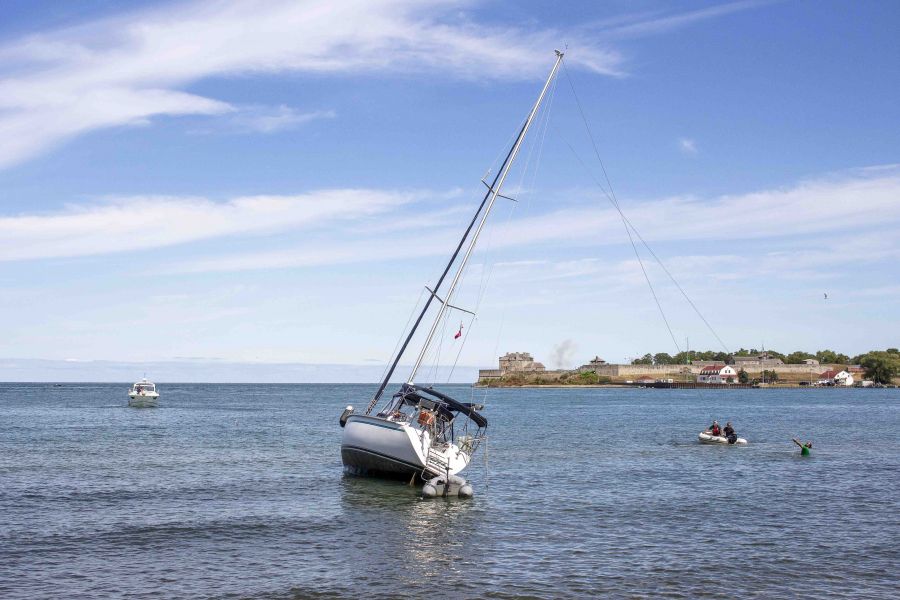A 35-foot sailboat that ran aground on a sandbar off Queen’s Royal Park on the windy evening of Sept. 1 was finally freed two days later.
After a dramatic nighttime rescue by Niagara-on-the-Lake Fire & Emergency Services Department, a group of residents tried unsuccessfully to dislodge the boat. It remained stuck in the sandbar until about 9:30 p.m. on Sept. 3 when it was pulled loose by C-Tow Marine Assistance Ltd.
No one was injured and the sailboat survived the ordeal unscathed.
The water where the Niagara River meets Lake Ontario near Queen’s Royal is shallow and a prominent sandbar runs hundreds of feet not far from shore.
The sailboat got stuck and was listing to the starboard side with its keel wedged firmly into the bar, keeping it tipped over for almost two days. The water is only a few feet deep where it sat.
The keel is a large fin that juts into the water underneath a sailboat from the centre of its hull and helps keep the craft stable.
The sailboat was flying an Aquatic Park Sailing Club flag, a yacht club out of Tommy Thompson Park in Toronto.
The boat also had a vice commodore flag, an ensign flown by current and former yacht club vice-presidents across North America, NOTL sailing club member Barry Solomon said.
Commodore and vice commodore flags represent a sailor with experience and rank in their respective yacht club, he said.
"That's pretty embarrassing," Solomon said with a wry grin.
The sailboat anchored around 7:30 p.m. in the Niagara River on Sept. 1, not too far from the sandbank, said Delater Street resident Terry Boulton.
Boulton watched the entire event unfold and said there was a man and woman aboard the boat.
“I thought, ‘What is this guy doing?’ ” Boulton said in an interview.
“We watched for maybe an hour from my living room and I thought, ‘Uh-oh, he’s dragging.’ And I knew he was in a very bad place.”
Dragging anchor is a sailing term for when a boat gets pushed by wind, waves or currents even though its anchor is down. It is considered extremely dangerous since the pressure exerted on the anchor’s cable from the force of the moving boat makes it impossible to raise the anchor and regain control of the vessel, Boulton said.
Boulton has lived in NOTL his whole life and started sailing with his father when he was a child.
He said Canadian Coast Guard boats came and shone spotlights on the sailboat. The American Coast Guard was also present.
“They can’t come in here, it’s way too shallow," he said.
The boat was being broadsided by the wind and waves for a while. At one point the craft was keeled over so far the railing on one side was completely submerged, he said.
Eventually the boat was pushed onto and over the sandbar, where it remained firmly stuck in the sand between the shore and the bar.
These events set the scene for a dramatic night rescue performed by NOTL firefighters.
Fire Chief Nick Ruller said his team received a dispatch call at 1:10 a.m. and arrived promptly on the scene.
The fire department received reports that the sailboat had anchored farther up the Niagara River. The current dragged the boat down to Lake Ontario, where the wind and waves began to push it toward the shore, Ruller said.
NOTL firefighters dispatched a pumper truck and brought two four-man rescue boats to the scene, in co-operation with the St. Catharines fire department.
"We reached out to the Canadian Coast Guard but they advised they were unable to get any closer or secure the boat because of the conditions," Ruller said.
The Canadian Coast Guard offered to bring in air support but Ruller and his team decided on another way.
"Knowing that we do have a bit of a sandbar there this year and that it was exceptionally shallow we felt the best strategy would be to send a couple of firefighters in to do the rescue and utilize the dinghy that was on the back of the sailboat," Ruller said.
Firefighters waded out in the water as the wind howled across Lake Ontario from the north. They secured the dinghy with ropes to the shore and used it to shuttle the sailors to dry land.
Occupants of the sailboat were safe and sound on shore by 1:53 a.m., Ruller said.
Although water rescues are rare and dangerous, the fire department was prepared and trained for it, the chief said.
Even in the middle of a windy night, NOTLers were eager to help the struggling strangers.
"There were a few residents nearby, one of them was a bed and breakfast owner that offered up a room for them, if they needed," Ruller said.
"It's always nice to see that community element."
Once the occupants were safe attention turned to the strenuous task of removing the sailboat from the sandbar.
Since the boat was being supported by its keel, every time a wave rocked the vessel the keel got hammered into the hull.
“If (the keel) is punched through (the hull) and they try to drag it off, what happens? Does it sink?” Boulton mused.
The boat's captain contacted C-Tow to aid in removing the boat but the company was not able to help immediately.
“Busy, busy day,” C-Tow representative Paul Gales said in an interview.
Gales offered some insight into how C-Tow frees boats in similar situations.
The company can use inflatable lift bags to elevate a boat so it can be floated over a sandbar, Gales said.
When a boat's keel is wedged deeply into a sandbar, C-Tow can use a high-powered water hose to clear the sand away from the keel in the water.
Gales said they can also lean a boat onto its side and float it out, which is exactly what a group of residents tried to do when C-Tow informed the sailboat's owner they were delayed.
Paddle Niagara's Tim Balasiuk and a crew of residents, organized by NOTL sailing club member Rick Sherk, attempted to free the sailboat on the afternoon of Sept. 3.
Balasiuk strung ropes around the sailboat's halyard, or mainmast, to try to flip it onto its side. Balasiuk yanked with his own bodyweight on one rope while Paul Kocsis pulled the other with a dinghy.
While this was happening, NOTL residents Steph Tribe, Marty, Ty and Shane Sherlock gathered onto the starboard (right) side of the sailboat and tried to use their bodyweight to lean it over further.
Vaughan Goettler, another NOTLer, arrived with his boat to try to pull the sailboat over the sandbar while this was happening. They were unsuccessful.
“If we had more people I think we would have been able to do it,” Balasiuk said in an interview Monday.
And while the civilian attempt failed, the altruistic residents were on the right track. The method they used was the same one professionals from C-Tow used to free the boat later that day.
Ed Yglesias of On Your Way Marine in Severn, Ont., also works for C-Tow. Yglesias, Adrian Kennedy and Craig Russell spent well over seven hours on Friday, Sept. 3, driving from Severn and freeing the sailboat from the sandbar.
They arrived on the scene around 7 p.m. and had the sailboat floating free around 9:30, roughly 48 hours after the whole ordeal started.
Yglesias said Kennedy and Russell worked a larger boat while he drove a small motor boat. The small boat put ropes around the halyard and flipped the sailboat onto its side, Yglesias said.
Once it was flipped, the crew floated the sailboat west down the shore to a point where the sandbar was a little deeper and attached ropes to the bow of the sailboat from the stern of the tow boat.
“We leaned it on its side while the big boat pulled it. It was pretty straightforward, uneventful and simple,” Yglesias said.
There was never any doubt that they could pull the sailboat over the sandbar, the real question was how safely that could be done.
“We have enough horsepower to just drag it out. But the key was and the whole reason of leaning it on its starboard side was to minimize damages,” Yglesias said.
“You can actually break the keel or the bolts that hold the keel in place can get compromised and then the boat starts taking on water.”
But it seems the boys from C-Tow did about as good a job as one could hope.
“From the assessment we did, we could not see any damages,” Yglesias said.
“Our main goal in a situation like this is not only getting the customer out safe but obviously minimizing the damage for the client.”
And with that, an uncommonly eventful 48 hours at Queen's Royal Park was brought to a close.











